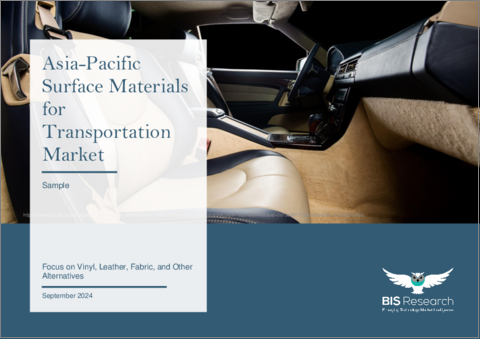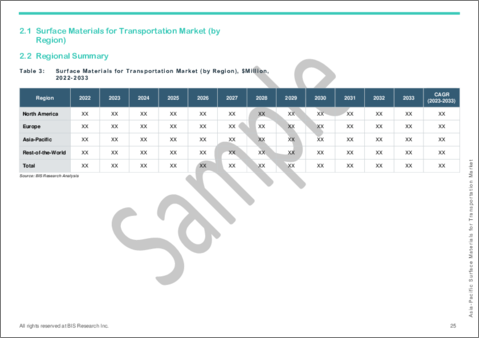|
|
市場調査レポート
商品コード
1570641
アジア太平洋の輸送用表面材市場:ビニール、皮革、布地、その他Asia-Pacific Surface Materials for Transportation Market: Focus on Vinyl, Leather, Fabric, and Other Alternatives |
||||||
カスタマイズ可能
|
|||||||
| アジア太平洋の輸送用表面材市場:ビニール、皮革、布地、その他 |
|
出版日: 2024年10月17日
発行: BIS Research
ページ情報: 英文 79 Pages
納期: 1~5営業日
|
全表示
- 概要
- 図表
- 目次
アジア太平洋の輸送用表面材の市場規模は、2023年の182億6,000万米ドルから2033年には388億7,000万米ドルに達し、予測期間の2023年~2033年のCAGRは7.84%になると予測されています。
自動車、鉄道、海洋、航空などの重要な産業が成長を続けているため、椅子張り、ダッシュボード、ヘッドライナーなどの表面材はアジア太平洋(APAC)輸送市場で高い需要があります。2023年から2033年にかけて、特に中国、インド、日本、韓国を含む主要アジア太平洋経済圏の自動車産業における表面材の使用量の増加により、市場は拡大すると予測されます。アフターマーケットカスタマイゼーションの人気の高まりも、特に織物、合成皮革、天然皮革、不織布といった素材の表面材需要を押し上げています。これはおそらく、この地域の自動車生産台数の増加とともに市場拡大に拍車をかけると思われます。しかし、消費者の取り込みは、価格に敏感なアジア太平洋市場では、設置コストの増大や原材料価格の変動といった問題によって妨げられる可能性があります。
| 主要市場統計 | |
|---|---|
| 予測期間 | 2023年~2033年 |
| 2023年の評価 | 182億6,000万米ドル |
| 2033年の予測 | 388億7,000万米ドル |
| CAGR | 7.84% |
アジア太平洋の輸送用表面材市場は、航空、鉄道、自動車、船舶などの重要産業の成長により、大きな発展が見込まれています。同地域では急速に工業化が進み、都市化が進み、最先端の輸送ソリューションに対する消費者の需要が高まっているため、内装、ダッシュボード、天井、床などの表面材の需要が高まっています。
この拡大は、中国、インド、日本、韓国などの主要経済国が牽引しており、特に自動車部門が重要です。テキスタイル、合成皮革、天然皮革、不織布を含む表面素材のニーズは、アフターマーケットのカスタマイズ傾向の拡大と自動車生産の増加の両方の結果として高まっています。耐久性、快適性、美観を向上させるために、自動車の内装にこれらの素材が広く使用されていることが市場成長の原動力となっています。
さらに、この地域の持続可能性への注目は、二酸化炭素排出量の削減を目指す世界の動向と一致し、環境に優しい表面材料の開発を促進しています。とはいえ、価格に敏感なアジア太平洋市場では、原材料価格の変動や設置費用の高騰など、特定の障害が顧客の導入に影響を及ぼす可能性があります。
当レポートでは、アジア太平洋の輸送用表面材市場について調査し、市場の概要とともに、用途別、販売チャネル別、最終用途産業別、材料タイプ別、地域別の動向、および市場に参入する企業のプロファイルなどを提供しています。
目次
エグゼクティブサマリー
第1章 市場:業界の展望
- 動向:現在および将来の影響評価
- サプライチェーンの概要
- 研究開発レビュー
- ステークホルダー分析
- 市場力学の概要
- 表面材と自動車の進歩の統合
- 表面材の選択基準
第2章 輸送用表面材市場(地域別)
- 輸送用表面材市場(地域別)
- 地域別概要
- アジア太平洋
第3章 市場- 競争環境と企業プロファイル
- 今後の見通し
- 地理的評価
- 競合ベンチマーキング
- 市場シェア分析(材料タイプ別)
- 企業プロファイル
- Toray Industries, Inc.
- Teijin Limited
- Sekisui Chemical Co., Ltd.
- Kuraray Co. Ltd.
第4章 調査手法
List of Figures
- Figure 1: Region with Largest Share of Market, 2022, 2026, and 2033
- Figure 2: Asia-Pacific Surface Materials for Transportation Market (by Application), 2022, 2026, and 2033
- Figure 3: Asia-Pacific Surface Materials for Transportation Market (by Sales Channel), 2022, 2026, and 2033
- Figure 4: Asia-Pacific Surface Materials for Transportation Market (by End-Use Industry), 2022, 2026, and 2033
- Figure 5: Asia-Pacific Surface Materials for Transportation Market (by Material Type), 2022, 2026, and 2033
- Figure 6: Surface Materials for Transportation Market, Recent Developments
- Figure 7: Supply Chain Analysis for Surface Materials for Transportation Market
- Figure 8: Patent Filed (by Company), January 2020-December 2023
- Figure 9: Patent Filed (by Country), January 2020-December 2023
- Figure 10: Impact Analysis of Market Navigating Factors, 2022-2033
- Figure 11: China Surface Materials for Transportation Market, $Million, 2022-2033
- Figure 12: Japan Surface Materials for Transportation Market, $Million, 2022-2033
- Figure 13: Australia Surface Materials for Transportation Market, $Million, 2022-2033
- Figure 14: South Korea Surface Materials for Transportation Market, $Million, 2022-2033
- Figure 15: India Surface Materials for Transportation Market, $Million, 2022-2033
- Figure 16: Rest-of-Asia-Pacific Surface Materials for Transportation Market, $Million, 2022-2033
- Figure 17: Strategic Initiatives, 2020-2023
- Figure 18: Share of Strategic Initiatives
- Figure 19: Data Triangulation
- Figure 20: Top-Down and Bottom-Up Approach
- Figure 21: Assumptions and Limitations
List of Tables
- Table 1: Market Snapshot
- Table 2: Surface Materials for Transportation Market, Regional Opportunities
- Table 3: Surface Materials for Transportation Market (by Region), $Million, 2022-2033
- Table 4: Asia-Pacific Surface Materials for Transportation Market (by Application), $Million, 2022-2033
- Table 5: Asia-Pacific Surface Materials for Transportation Market (by Sales Channel), $Million, 2022-2033
- Table 6: Asia-Pacific Surface Materials for Transportation Market (by End-Use Industry), $Million, 2022-2033
- Table 7: Asia-Pacific Surface Materials for Transportation Market (by Material Type), $Million, 2022-2033
- Table 8: China Surface Materials for Transportation Market (by Application), $Million, 2022-2033
- Table 9: China Surface Materials for Transportation Market (by Sales Channel), $Million, 2022-2033
- Table 10: China Surface Materials for Transportation Market (by End-Use Industry), $Million, 2022-2033
- Table 11: China Surface Materials for Transportation Market (by Material Type), $Million, 2022-2033
- Table 12: Japan Surface Materials for Transportation Market (by Application), $Million, 2022-2033
- Table 13: Japan Surface Materials for Transportation Market (by Sales Channel), $Million, 2022-2033
- Table 14: Japan Surface Materials for Transportation Market (by End-Use Industry), $Million, 2022-2033
- Table 15: Japan Surface Materials for Transportation Market (by Material Type), $Million, 2022-2033
- Table 16: Australia Surface Materials for Transportation Market (by Application), $Million, 2022-2033
- Table 17: Australia Surface Materials for Transportation Market (by Sales Channel), $Million, 2022-2033
- Table 18: Australia Surface Materials for Transportation Market (by End-Use Industry), $Million, 2022-2033
- Table 19: Australia Surface Materials for Transportation Market (by Material Type), $Million, 2022-2033
- Table 20: South Korea Surface Materials for Transportation Market (by Application), $Million, 2022-2033
- Table 21: South Korea Surface Materials for Transportation Market (by Sales Channel), $Million, 2022-2033
- Table 22: South Korea Surface Materials for Transportation Market (by End-Use Industry), $Million, 2022-2033
- Table 23: South Korea Surface Materials for Transportation Market (by Material Type), $Million, 2022-2033
- Table 24: India Surface Materials for Transportation Market (by Application), $Million, 2022-2033
- Table 25: India Surface Materials for Transportation Market (by Sales Channel), $Million, 2022-2033
- Table 26: India Surface Materials for Transportation Market (by End-Use Industry), $Million, 2022-2033
- Table 27: India Surface Materials for Transportation Market (by Material Type), $Million, 2022-2033
- Table 28: Rest-of-Asia-Pacific Surface Materials for Transportation Market (by Application), $Million, 2022-2033
- Table 29: Rest-of-Asia-Pacific Surface Materials for Transportation Market (by Sales Channel), $Million, 2022-2033
- Table 30: Rest-of-Asia-Pacific Surface Materials for Transportation Market (by End-Use Industry), $Million, 2022-2033
- Table 31: Rest-of-Asia-Pacific Surface Materials for Transportation Market (by Material Type), $Million, 2022-2033
- Table 32: Market Share (by Material Type, Vinyl), 2022
- Table 33: Market Share (by Material Type, Leather), 2022
- Table 34: Market Share (by Material Type, Fabric), 2022
- Table 35: Market Share (by Material Type, Sustainable Materials), 2022
Introduction to Asia-Pacific Surface Materials for Transportation Market
The Asia-Pacific surface materials for transportation market is projected to reach $38.87 billion by 2033 from $18.26 billion in 2023, growing at a CAGR of 7.84% during the forecast period 2023-2033. Surface materials including upholstery, dashboards, and headliners are in high demand in the Asia-Pacific (APAC) transportation market as important industries like automotive, rail, marine, and aviation continue to grow. From 2023 to 2033, the market is anticipated to increase due to the growing usage of surface materials, especially in the automotive industry in major APAC economies including China, India, Japan, and South Korea. The growing popularity of aftermarket customization is also driving up demand for surface materials, particularly for materials like textiles, leather, both synthetic and natural, and non-wovens. This will probably spur market expansion together with the region's increasing car production. Consumer uptake, however, may be hampered by issues like growing installation costs and volatile raw material prices in the price-sensitive APAC market.
Market Introduction
| KEY MARKET STATISTICS | |
|---|---|
| Forecast Period | 2023 - 2033 |
| 2023 Evaluation | $18.26 Billion |
| 2033 Forecast | $38.87 Billion |
| CAGR | 7.84% |
The market for surface materials for transportation in Asia-Pacific (APAC) is expected to develop significantly due to the growth of important industries like aviation, rail, automobile, and marine. With the region rapidly industrializing, becoming more urbanized, and seeing a rise in consumer demand for cutting-edge transportation solutions, surface materials such as upholstery, dashboards, headliners, and floors are in high demand.
This expansion is being driven by major economies such as China, India, Japan, and South Korea, with the automotive sector being particularly important. The need for surface materials including textiles, synthetic and natural leather, and non-wovens is rising as a result of both the expanding aftermarket customisation trend and the rising vehicle production. Market growth is fueled by the widespread usage of these materials in car interiors to improve durability, comfort, and aesthetics.
Additionally, the region's focus on sustainability is driving the development of eco-friendly surface materials, matching with global trends toward lowering carbon footprints. Notwithstanding, certain obstacles such as volatile raw material prices and escalating installation expenses in the price-sensitive Asia-Pacific market may influence customer adoption.
Despite these obstacles, it is anticipated that between 2023 and 2033, the surface materials market in the APAC region will continue to rise due to ongoing technical advancements and the growing significance of individualized transportation solutions.
Market Segmentation
Segmentation 1: by Application
- Upholstery
- Headliner
- Dashboard
- Others
Segmentation 2: by Sales Channel
- OEM
- Aftermarket
Segmentation 3: by End-Use Industry
- Automotive
- Marine
- Aviation
- Rail
Segmentation 4: by Material Type
- Vinyl
- Leather
- Fabric
- Other Sustatinable Alternatives
Segmentation 5: by Region
- Asia-Pacific - China, Japan, Australia, South Korea, India, and Rest-of-Asia-Pacific
How can this report add value to an organization?
Product/Innovation Strategy: The product segment helps the reader understand the different surface materials, various sales channels such as OEM and aftermarket, end-use industries, and different material types involved in the production of surface materials. Moreover, the study provides the reader with a detailed understanding of the Asia-Pacific surface materials for transportation market based on the end user (automotive, marine, aviation, rail and others).
Growth/Marketing Strategy: The Asia-Pacific surface materials for transportation market has seen major development by key players operating in the market, such as business expansions, partnerships, collaborations, mergers and acquisitions, and joint ventures. The favored strategy for the companies has been product developments, business expansions, and acquisitions to strengthen their position in the global surface materials for transportation market.
Competitive Strategy: Key players in the Asia-Pacific surface materials for transportation market analyzed and profiled in the study involve surface materials manufacturers and the overall ecosystem. Moreover, a detailed competitive benchmarking of the players operating in the surface materials for transportation market has been done to help the reader understand how players stack against each other, presenting a clear market landscape. Additionally, comprehensive competitive strategies such as partnerships, agreements, acquisitions, and collaborations will aid the reader in understanding the untapped revenue pockets in the market.
Key Market Players and Competition Synopsis
The companies that are profiled have been selected based on inputs gathered from primary experts and analysing company coverage, product portfolio, and market penetration.
Some of the prominent companies in this market are:
- Toray Industries, Inc.
- Teijin Limited
- Sekisui Chemical Co., Ltd.
- Kuraray Co. Ltd.
Table of Contents
Executive Summary
Scope of the Study
Scope and Definition
1 Market: Industry Outlook
- 1.1 Trends: Current and Future Impact Assessment
- 1.1.1 Trend Analysis: Surface Materials for Transportation Market
- 1.1.2 Increasing Adoption of Luxury and Performance Vehicles
- 1.1.3 Changing Consumer Behavior toward Comfort and Aesthetics in Transportation
- 1.2 Supply Chain Overview
- 1.2.1 Value Chain Analysis
- 1.2.2 Pricing Forecast (by Material Type, $/Meter)
- 1.3 Research and Development Review
- 1.3.1 Patent Filing Trend (by Country, Company)
- 1.4 Stakeholder Analysis
- 1.4.1 Use Case
- 1.4.2 End User and Buying Criteria
- 1.5 Market Dynamics Overview
- 1.5.1 Market Drivers
- 1.5.1.1 Increase in Demand for Aftermarket Customer Modifications
- 1.5.1.2 Increase in Vehicle Production
- 1.5.2 Market Challenges
- 1.5.2.1 High Material and Installation Cost
- 1.5.2.2 Increase in Regulations for Materials
- 1.5.3 Market Opportunities
- 1.5.3.1 Advancements in Technology for Surface Materials
- 1.5.3.2 Growth in Adoption of Smart Features
- 1.5.1 Market Drivers
- 1.6 Integration of Surface Materials with Ongoing Automotive Advancements
- 1.7 Selection Criteria for Surface Materials
- 1.7.1 Key Comparisons between Fabrics and Properties
- 1.7.1.1 Vinyl
- 1.7.1.2 Natural Leather
- 1.7.1.2.1 Synthetic Leather
- 1.7.1.2.2 Polyurethane (PU)
- 1.7.1.2.3 Polyvinyl Chloride (PVC)
- 1.7.1.2.4 Polyester
- 1.7.1.2.5 Others
- 1.7.1.3 Fabric
- 1.7.1.3.1 Polyester
- 1.7.1.3.2 Natural Fabric
- 1.7.1.3.3 Wool/Nylon Blend
- 1.7.1.4 Other Sustainable Alternatives
- 1.7.1.4.1 Recycled Materials
- 1.7.1.4.2 Plant- and Bio-Based Materials
- 1.7.1.4.3 Bio-Based Fabric
- 1.7.2 Evaluation of Chemical Composition
- 1.7.3 Application-Wise Compatibility
- 1.7.1 Key Comparisons between Fabrics and Properties
2 Surface Materials for Transportation Market (by Region)
- 2.1 Surface Materials for Transportation Market (by Region)
- 2.2 Regional Summary
- 2.3 Asia-Pacific
- 2.3.1 Market
- 2.3.1.1 Key Market Participants in Asia-Pacific
- 2.3.1.2 Business Drivers
- 2.3.1.3 Business Challenges
- 2.3.2 Application
- 2.3.3 Product
- 2.3.4 Asia-Pacific (by Country)
- 2.3.4.1 China
- 2.3.4.1.1 Application
- 2.3.4.1.2 Product
- 2.3.4.2 Japan
- 2.3.4.2.1 Application
- 2.3.4.2.2 Product
- 2.3.4.3 Australia
- 2.3.4.3.1 Application
- 2.3.4.3.2 Product
- 2.3.4.4 South Korea
- 2.3.4.4.1 Application
- 2.3.4.4.2 Product
- 2.3.4.5 India
- 2.3.4.5.1 Application
- 2.3.4.5.2 Product
- 2.3.4.6 Rest-of-Asia-Pacific
- 2.3.4.6.1 Application
- 2.3.4.6.2 Product
- 2.3.4.1 China
- 2.3.1 Market
3 Markets - Competitive Landscaped and Companies Profiled
- 3.1 Next Frontiers
- 3.2 Geographical Assessment
- 3.3 Competitive Benchmarking
- 3.4 Market Share Analysis (by Material Type)
- 3.5 Company Profiles
- 3.5.1 Toray Industries, Inc.
- 3.5.1.1 Overview
- 3.5.1.2 Top Products/Product Portfolio
- 3.5.1.3 Top Competitors
- 3.5.1.4 Target Customers/End-Use Industries
- 3.5.1.5 Key Personnel
- 3.5.1.6 Analyst View
- 3.5.1.7 Market Share (2022)
- 3.5.2 Teijin Limited
- 3.5.2.1 Overview
- 3.5.2.2 Top Products/Product Portfolio
- 3.5.2.3 Top Competitors
- 3.5.2.4 Target Customers/End-Use Industries
- 3.5.2.5 Key Personnel
- 3.5.2.6 Analyst View
- 3.5.2.7 Market Share (2022)
- 3.5.3 Sekisui Chemical Co., Ltd.
- 3.5.3.1 Overview
- 3.5.3.2 Top Products/Product Portfolio
- 3.5.3.3 Top Competitors
- 3.5.3.4 Target Customers/End-Use Industries
- 3.5.3.5 Key Personnel
- 3.5.3.6 Analyst View
- 3.5.3.7 Market Share (2022)
- 3.5.4 Kuraray Co. Ltd.
- 3.5.4.1 Overview
- 3.5.4.2 Top Products/Product Portfolio
- 3.5.4.3 Top Competitors
- 3.5.4.4 Target Customers/End-Use Industries
- 3.5.4.5 Key Personnel
- 3.5.4.6 Analyst View
- 3.5.4.7 Market Share (2022)
- 3.5.1 Toray Industries, Inc.
4 Research Methodology
- 4.1 Data Sources
- 4.1.1 Primary Data Sources
- 4.1.2 Secondary Data Sources
- 4.1.3 Data Triangulation
- 4.2 Market Estimation and Forecast





